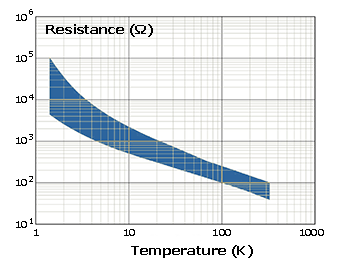Thermometry
Cernox CX-1050
The Cernox CX-1050 thermometers installed in our cryostats are calibrated with our own cryogenic thermometer calibration facility consisting of a liquid helium orange cryostat and a dedicated stick.
This stick features an isothermal copper block on which we can mount up to 21 thermometers and 4 standard reference thermometers. The standard thermometers are mounted at the top and bottom of the copper block: a Cernox CX-1030-AA-0.3L and a platinum PT-103-14L at each extremity.
These standard sensors have been calibrated by Lake Shore and their uncertainty is as follows:
| T (K) | 1.4 | 4.2 | 10 | 20 | 30 | 50 | 100 | 300 |
|---|---|---|---|---|---|---|---|---|
| CX-1030 (± mK) | 4 | 4 | 5 | 9 | 11 | 16 | 24 | 72 |
| PT-103 (± mK) | 8 | 8 | 10 | 11 | 22 |
We use a 4-lead AC measurement technique to achieve the best possible accuracy with the lowest possible excitation. Two LakeShore Model 370 connected to Model 3716 scanners are used in voltage excitation mode to limit the excitation power. For each temperature, the appropriate resistance range is selected by the Igor Pro data acquisition program. Once the temperature of the reference sensors is stabilized, the program launches a series of measurements of the sensors. The series is repeated several times and the data are averaged for each sensor. The temperature ranges of the calibration are defined as follows:
| Tmin (K) | Tmax (K) | ∆T (K) | Tmin (K) | Tmax (K) | ∆T (K) |
|---|---|---|---|---|---|
| 1.40 | 2.00 | 0.10 | 29.0 | 50.0 | 3.0 |
2.00 | 6.00 | 0.20 | 50.0 | 105.0 | 5.0 |
| 6.00 | 29.00 | 1.00 | 105.0 | 325.0 | 10.0 |
The best accuracy is obtained by using the CX-1030 reference values below 30K and the the PT-103 values above. To measure temperature from a Cernox sensor, a Chebychev polynomial fit to the measured calibration data is used to convert the sensor resistance to a temperature. We perform calibration fits in the ranges 1.3 - 14K, 14 - 82K and 82 - 325K and produce a LakeShore 340 ASCII file containing 200 interpolation points between 1.3 and 330K (a fewer less points if the temperature range cannot be fully covered by the cryostat used). We also produce a plot of the calibration curve in PNG format. On request, we can also supply the fitting parameters of the Chebyshev polynomials.
The uncertainty of the measurement is evaluated from:

where k = 2 (95% confidence level), and urep, ucal and u370 are the uncertainties related respectively to the repeatability, the calorimeter and the LakeShore Model 370. For example, at 2K, we get u370 = 0.21mK, ucal = 2mK and urep = 0.1mK leading to Umes = ±4.2 mK. The final uncertainty also takes into account the uncertainty related to the reference sensor, the polynomial fit of the reference and calibrated sensors. Globally, this leads to an uncertainty which is roughly twice the one of the reference thermometers listed in the above table. So for example, our thermometers have a uncertainty of about ±10mK at 10K and ±44mK at 300K.
Platinum Pt-100
In each cryostat and at the bottom of each sample stick, we generally also provide a platinum Pt-100 thermometer. The calibration curve is shown below and can be downloaded for a LakeShore in Ohms vs Kelvin (txt - 5.70 Ki) format.


